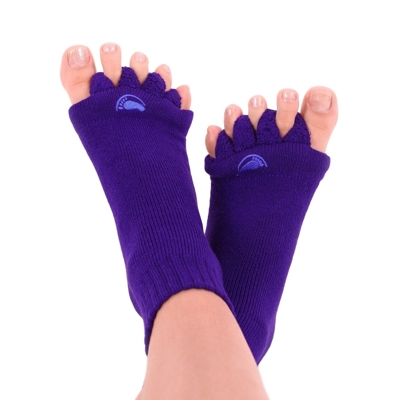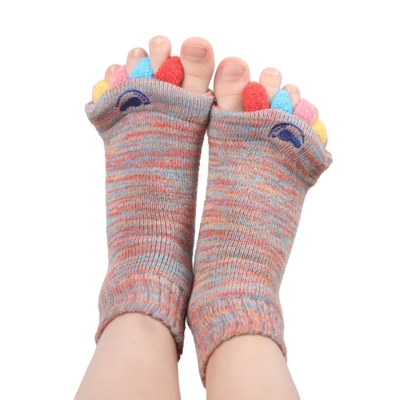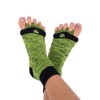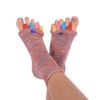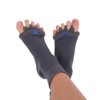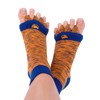Physiotherapist Bc. Veronika Homolková: Foot Alignment Socks can be a valuable part of treatment
 How can a physiotherapist help you, and what can a podiatrist do for you? Do you know which of them you should consult? Are you interested in knowing the most common reasons why Veronika Homolková’s clients seek out a physiotherapist or how various possible foot disorders can be diagnosed? If so, read this interesting interview.
How can a physiotherapist help you, and what can a podiatrist do for you? Do you know which of them you should consult? Are you interested in knowing the most common reasons why Veronika Homolková’s clients seek out a physiotherapist or how various possible foot disorders can be diagnosed? If so, read this interesting interview.
 First, a few words about Veronika Homolková
First, a few words about Veronika Homolková
Veronika Homolková is a physiotherapist-podotherapist, who has spent more than 10 years working for Reha-Praktik, which runs an out-patient rehabilitation and physiotherapy centre. At the same time, Veronika is launching her own project, PhysioFeet, which aims to use online courses and other methods to teach clients how to care for their feet, to walk properly, to choose suitable footwear, and other related topics.
Do you specialise in any specific aspect of physiotherapy?
I specialise in feet – from treatment using a podoscope, a pedobarograph, using a camera system to analyse a person’s gait, individual adjustments of shoe insoles, and Nordic walking sessions, through to kinesio taping and so on. In general, I naturally work with the whole range of diagnoses – vertebropathy, post-operative and post-traumatic conditions, etc. I also work with children, professionals and amateur athletes, who most often play rugby, go cycling, do fire sports + TFA contests, or play hockey, for example.
What’s the most common foot-related diagnosis that your patients come to you with?
In most cases, clients come to me saying they have flat feet. I carry out an examination and either completely or partially refute this. I suppose the most common problem I deal with is a medial collapse of the ankle, i.e. hyperpronation. However, bunions are also common – various types such as hallux valgus or hallux rigidus...
When should people visit a physiotherapist and when should they see a podiatrist?
It depends on the diagnosis and the problems the client is experiencing. In my opinion, the optimal procedure is this: the client goes to see a physiotherapist, and if the physiotherapist is unable to help (he or she does not specialise in feet), the client will be referred to a physio-podotherapist, and they should then decide whether the client needs to see a podiatrist. Basically, a physio-podotherapist should be able to deal with anything that does not require surgery, while a podiatrist should deal with problems that require an operation.

What do you personally recommend with regard to preventive foot care?
Definitely start to look after your feet. Problems with the foot can mean problems with the entire musculoskeletal system. Let’s imagine, especially we ladies, how many times a week we put cream on our face, hands, body...? And our feet? And what about a pedicure? For some people, unfortunately, this is a completely unfamiliar word.
How do you think people view prevention? And do they deal with any complications in time or leave it to the last minute?
I think the word prevention carries some weight nowadays. The question is, prevention of what? If we’re talking about teeth, for instance, we all clean our teeth at least twice a day and don’t give it too much thought. But with the feet it’s a problem. Here, we deal with ailments either late or right at the very last minute.
What do you think about Foot Alignment Socks? Do you wear them yourself? Do you recommend them to your patients?
Foot Alignment Socks are one of my favourite products. I’ve been wearing them for several years and I really do like to recommend them to my patients. Women love them and recently there have also been some men who have “taken a fancy” to them.

Do you consider wearing Foot Alignment Socks merely part of preventive care or can they also be included in treatment?
As far as Foot Alignment Socks go, I’d definitely say for prevention first, although with some clients and diagnoses they can indeed be a valuable part of treatment.
What would you say is the benefit in wearing Foot Alignment Socks? How do they help?
I recommend Foot Alignment Socks mainly for preventive reasons, to ease tension in the foot. Clients often tell me that when they use Foot Alignment Socks, they feel relief from pain in their soles and instep after a hard day, and that these socks alleviate or completely eliminate problems associated with restless legs syndrome. Some clients even take photos of their feet so that they can observe how their big toe improves when being treated for hallux valgus – a bunion.
Another benefit I see is that they can be used repeatedly. The feet can also be taped, but unfortunately the tape doesn’t stay on the foot for very long and needs to be re-applied often. This is not a problem with socks, and anyone can put them on without needing to go and see a physiotherapist.


